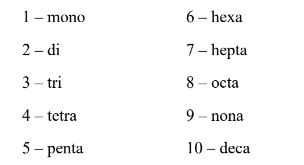Nomenclature of Inorganic Compounds
1/24
There's no tags or description
Looks like no tags are added yet.
Name | Mastery | Learn | Test | Matching | Spaced |
|---|
No study sessions yet.
25 Terms
_ are made up of two elements, a metal and a non-metal
Binary compounds
Composed of hydrogen and an acid-forming non-metal (typically from the halogen family: fluorine, chlorine, iodine, bromine).
To form the name of the acid:
Remove the last three letters of the non-metal’s name to get the stem.
Example: Chlorine → Chlor-
Use the following rule: hydro + stem of the non-metal + -ic + acid
binary acids
Examples:
HCl → Hydrochloric acid
HBr → Hydrobromic acid
HF → Hydrofluoric acid
binary acids
Composed of a metal ion and a non-metal ion
Naming rule: name of metal + stem of the non-metal + -ide
binary salts
Examples:
NaCl → Sodium chloride
KI → Potassium iodide
LiBr → Lithium bromide
binary salts
Use the English name of the metal followed by a Roman numeral (in parentheses) to indicate the oxidation state of the metal
stock method
Examples:
FeCl₂ → Iron (II) chloride
FeCl₃ → Iron (III) chloride
SnBr₂ → Tin (II) bromide
SnBr₄ → Tin (IV) bromide
stock method
Use the stem of the Latin name of the metal, ending with suffixes -ous (for lower oxidation state) or -ic (for higher oxidation state), followed by the name of the non-metal ending in -ide
classical (old) method
Examples:
FeCl₂ → Ferrous chloride
FeCl₃ → Ferric chloride
SnBr₂ → Stannous bromide
SnBr₄ → Stannic bromide
classical (old) method
__ are used to distinguish compounds of the same elementary composition
Greek prefixes
Compounds of Two Non-metals
To name the compound correctly, state the name of the __
less electronegative element first, followed by the other element ending in -ide

what is this?
Greek prefixes
How do you write CO? (two non-metals)
Carbon monoxide
How do you write CO₂? (two non-metals)
Carbon dioxide
How do you write N₂O₄? (two non-metals)
Dinitrogen tetroxide
How do you writePCl₅? (two non-metals)
Phosphorus pentachloride
made up of three elements: metal, non-metal, and oxygen
ternary compounds
Composed of hydrogen, an acid-forming non-metal, and oxygen
ternary acids (oxyacids)
Use the stem of the central atom ending in either -ous or -ic followed by the word acid
-ous: Used for lower numbers of oxygen atoms.
-ic: Used for higher numbers of oxygen atoms.
ternary acids (oxyacids)
HNO₂ → Nitrous acid
HNO₃ → Nitric acid
HClO₂ → Chlorous acid
HClO₃ → Chloric acid
ternary acids (oxyacids)
Additional Prefixes:
Hypo-: Indicates the presence of the very lowest number of oxygen atoms.
Per-: Indicates the presence of the very highest number of oxygen atoms.
ternary acids (oxyacids)
HClO → Hypochlorous acid
HClO₄ → Perchloric acid
ternary acids (oxyacids)
composed of a metal, non-metal, and oxygen.
ternary salts (salts of oxyacids)
Name of the metal followed by the stem of the central atom ending in either -ite or -ate depending on the number of oxygen atoms.
Retain the prefixes per- and hypo-; change suffixes from -ous to -ite and from -ic to -ate.
ternary salts (salts of oxyacids)
NaNO₂ → Sodium nitrite
NaNO₃ → Sodium nitrate
KClO → Potassium hypochlorite
KClO₂ → Potassium chlorite
KClO₃ → Potassium chlorate
KClO₄ → Potassium perchlorate
ternary salts (salts of oxyacids)